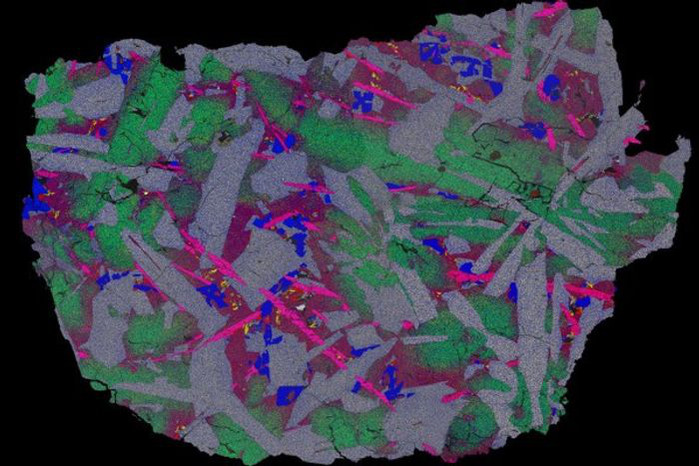Forskningsområden: Geovetenskap
Forskningsämnen: NordSIMS, Månens evolution
Forskningsområden: Geovetenskap
Forskningsämnen: NordSIMS, Månens evolution
Project overview
The overall purpose of this project is to characterize and date (with different isotopic systems) Moon samples collected by Apollo missions as well as lunar meteorites found on Earth to better understand the formation and evolution of the Moon.
Project description
The most widely accepted model for the formation of the Moon is that it originated from the debris generated during a giant impact between a Mars-sized body and the early Earth. It is thought that the heat produced as this debris accreted resulted in the formation of a global “magma ocean” covering the surface of the Moon.
The cooling and crystallization of this magma ocean led to the formation of the lunar crust and the reservoirs of material in the lunar mantle that would be subsequently erupted onto the Moon’s surface.
We have developed a new approach for determining precise crystallization ages of the lunar basalts that formed in these volcanic eruptions, by analyzing their lead (Pb) isotopic compositions using Secondary Ion Mass Spectrometry (SIMS). We are using these ages and isotopic compositions to construct a model that will help us to understand the sources of lunar volcanic activity, the evolution of the lunar magma ocean and, ultimately, when the Moon itself was formed.
Funding
Vetenskapsrådet (The Swedish Research Council)
Selected publications
· Snape J. F., Nemchin A. A., Bellucci J. J., Whitehouse M. J., Tartèse R., Barnes J. J., Anand M., Crawford I. A. and Joy K. H. (2016): Lunar basalt chronology, mantle differentiation and implications for determining the age of the Moon. Earth Planet. Sci. Lett. 451, 149-158 (http://dx.doi.org/10.1016/j.epsl.2016.07.026 Länk till annan webbplats.)
Länk till annan webbplats.)
· Snape, J.F., Davids, B., Nemchin, A.A., Whitehouse, M.J. and Bellucci, J.J., 2018. Constraining the timing and sources of volcanism at the Apollo 12 landing site using new Pb isotopic compositions and crystallisation ages. Chemical Geology, 482, pp.101-112 (https://doi.org/10.1016/j.chemgeo.2018.02.009 Länk till annan webbplats.)
Länk till annan webbplats.)
· Snape, J.F., Nemchin, A.A., Whitehouse, M.J., Merle, R.E., Hopkinson, T. and Anand, M., 2019. The timing of basaltic volcanism at the Apollo landing sites. Geochimica et Cosmochimica Acta, 266, pp.29-53 (https://doi.org/10.1016/j.gca.2019.07.042 Länk till annan webbplats.)
Länk till annan webbplats.)
· Merle, R.E., Nemchin, A.A., Whitehouse, M.J., Snape, J.F., Kenny, G.G., Bellucci, J.J., Connelly, J.N. and Bizzarro, M., 2020. Pb‐Pb ages and initial Pb isotopic composition of lunar meteorites: NWA 773 clan, NWA 4734, and Dhofar 287. Meteoritics & planetary science, 55(8) (https://doi.org/10.1111/maps.13547 Länk till annan webbplats.)
Länk till annan webbplats.)
Project participants
External participants
- Alexander Nemchin, Curtin University, Australia (https://staffportal.curtin.edu.au/staff/profile/view/alexander-nemchin-dd600e2d/
 Länk till annan webbplats.)
Länk till annan webbplats.) - Lars Borg, Lawrence Livermore National Laboratory, USA (https://people.llnl.gov/borg5)
 Länk till annan webbplats.
Länk till annan webbplats. - Brad Joliff, Washington University in St. Louis, USA (https://eps.wustl.edu/people/bradley-l-jolliff
 Länk till annan webbplats.)
Länk till annan webbplats.) - Renaud Merle, Uppsala University, Sweden (https://www.katalog.uu.se/profile/?id=N20-1198)
 Länk till annan webbplats.
Länk till annan webbplats. - Marc Norman, Australia National University, Australia (https://researchers.anu.edu.au/researchers/norman-md
 Länk till annan webbplats.)
Länk till annan webbplats.) - Joshua Snape, The University of Manchester, UK (https://research.manchester.ac.uk/en/persons/joshua.snape)
 Länk till annan webbplats.
Länk till annan webbplats. - The StarPlan group Copenhagen, Denmark (https://globe.ku.dk/research/starplan/
 Länk till annan webbplats, öppnas i nytt fönster.)
Länk till annan webbplats, öppnas i nytt fönster.)
Project Manager


